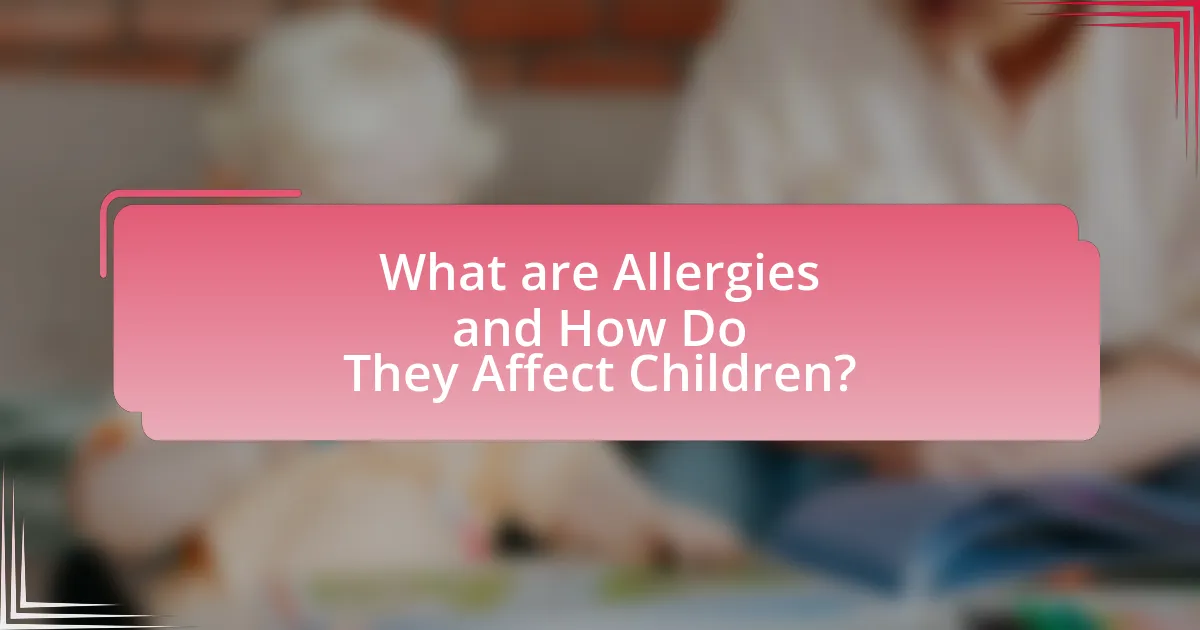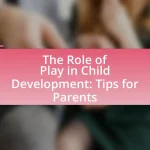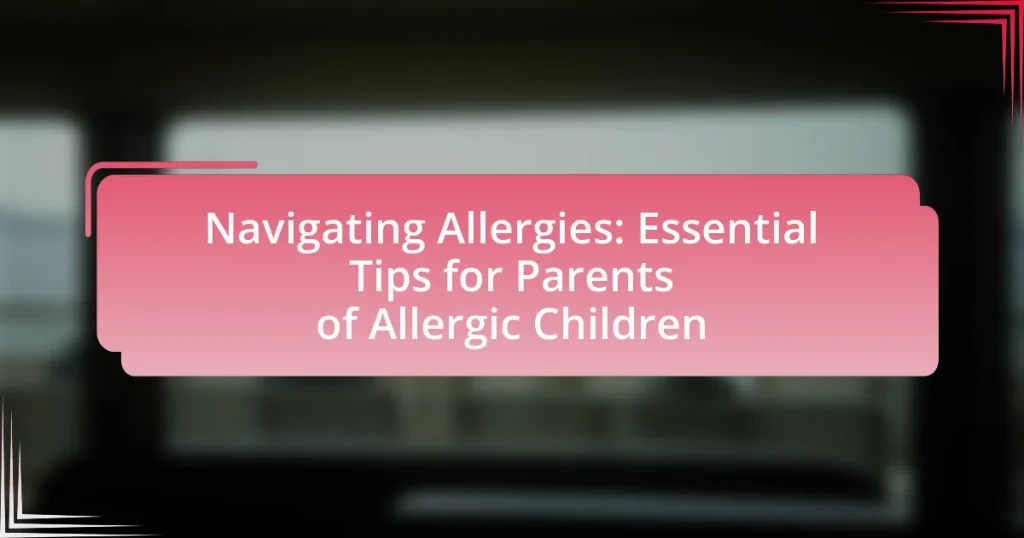The article “Navigating Allergies: Essential Tips for Parents of Allergic Children” provides a comprehensive overview of allergies in children, detailing their causes, symptoms, and management strategies. It highlights the role of genetic and environmental factors in the development of allergies, as well as common types such as food and seasonal allergies. Parents are guided on how to identify allergic reactions, differentiate them from other illnesses, and seek medical advice when necessary. The article also emphasizes practical strategies for managing allergies at home, including creating an allergy-friendly environment, effective communication with caregivers and schools, and utilizing available resources for ongoing support and education.

What are Allergies and How Do They Affect Children?
Allergies are immune system reactions to substances that are typically harmless, known as allergens, and they can significantly affect children by causing symptoms such as sneezing, itching, and difficulty breathing. In children, allergies can lead to conditions like asthma, eczema, and food allergies, which may result in severe reactions, including anaphylaxis. According to the American Academy of Pediatrics, approximately 8% of children in the United States have food allergies, highlighting the prevalence and potential severity of allergic reactions in this age group.
What causes allergies in children?
Allergies in children are primarily caused by the immune system’s overreaction to certain substances, known as allergens. Common allergens include pollen, dust mites, pet dander, mold, certain foods (like peanuts and shellfish), and insect stings. Research indicates that genetic predisposition plays a significant role, as children with a family history of allergies are more likely to develop them. Additionally, environmental factors, such as exposure to allergens at an early age and changes in diet, can influence the likelihood of developing allergies.
How do genetic factors contribute to allergies?
Genetic factors significantly contribute to the development of allergies by influencing an individual’s immune response and susceptibility to allergens. Research indicates that individuals with a family history of allergies are more likely to develop allergic conditions themselves, suggesting a hereditary component. For instance, studies show that if one parent has allergies, the child has a 30-50% chance of developing them, and this risk increases to 60-80% if both parents are affected. This genetic predisposition is linked to variations in genes that regulate immune system functions, such as those involved in the production of immunoglobulin E (IgE), which plays a crucial role in allergic reactions.
What environmental triggers are common for allergic reactions?
Common environmental triggers for allergic reactions include pollen, dust mites, mold, pet dander, and certain foods. Pollen from trees, grasses, and weeds can cause seasonal allergies, affecting millions of individuals annually. Dust mites thrive in household environments, particularly in bedding and upholstery, and are a leading cause of indoor allergies. Mold spores, which can be found in damp areas, also contribute to allergic reactions. Additionally, pet dander from cats and dogs is a frequent allergen for many people. According to the American College of Allergy, Asthma, and Immunology, these triggers are significant contributors to allergic rhinitis and asthma symptoms.
What are the common types of allergies in children?
Common types of allergies in children include food allergies, environmental allergies, and insect sting allergies. Food allergies often involve reactions to common allergens such as peanuts, tree nuts, milk, eggs, soy, wheat, fish, and shellfish, affecting approximately 5-8% of children. Environmental allergies can be triggered by pollen, dust mites, mold, and pet dander, with studies indicating that around 10-30% of children experience these types of allergies. Insect sting allergies, particularly from bees and wasps, can also pose significant risks, with severe reactions occurring in a small percentage of affected children.
How do food allergies manifest in children?
Food allergies in children typically manifest through a range of symptoms that can affect the skin, gastrointestinal system, respiratory system, and cardiovascular system. Common manifestations include hives, swelling, abdominal pain, vomiting, diarrhea, coughing, wheezing, and in severe cases, anaphylaxis, which is a life-threatening reaction that requires immediate medical attention. According to the American Academy of Pediatrics, approximately 6-8% of children are affected by food allergies, with reactions often occurring within minutes to a few hours after exposure to the allergenic food.
What are the symptoms of seasonal allergies?
The symptoms of seasonal allergies include sneezing, runny or stuffy nose, itchy or watery eyes, and itchy throat. These symptoms occur due to the body’s immune response to allergens such as pollen from trees, grasses, and weeds. According to the American College of Allergy, Asthma, and Immunology, approximately 30% of adults and 40% of children experience allergic rhinitis, which is commonly triggered by seasonal allergens.

How Can Parents Identify Allergies in Their Children?
Parents can identify allergies in their children by observing symptoms that occur after exposure to specific foods, environmental factors, or substances. Common signs include skin reactions like hives or eczema, respiratory issues such as sneezing or wheezing, and gastrointestinal problems like vomiting or diarrhea.
To confirm allergies, parents should keep a detailed diary of their child’s symptoms alongside their diet and activities, which can help identify patterns. Consulting with a healthcare professional for allergy testing, such as skin prick tests or blood tests, provides definitive diagnosis and helps in understanding the specific allergens involved. According to the American Academy of Pediatrics, approximately 6-8% of children have food allergies, emphasizing the importance of accurate identification and management.
What signs should parents look for in allergic reactions?
Parents should look for signs such as hives, swelling, difficulty breathing, and gastrointestinal symptoms in allergic reactions. Hives appear as raised, itchy welts on the skin, while swelling, particularly around the face, lips, or throat, can indicate a more severe reaction. Difficulty breathing may manifest as wheezing or shortness of breath, and gastrointestinal symptoms can include nausea, vomiting, or diarrhea. Recognizing these signs is crucial, as allergic reactions can escalate quickly, with severe cases leading to anaphylaxis, which requires immediate medical attention.
How can parents differentiate between allergies and other illnesses?
Parents can differentiate between allergies and other illnesses by observing specific symptoms and their onset. Allergies typically present with symptoms such as sneezing, itching, hives, or swelling shortly after exposure to an allergen, while illnesses like colds or flu often include fever, body aches, and prolonged symptoms. For instance, allergic reactions usually occur within minutes to hours after exposure to triggers like pollen or certain foods, whereas viral infections develop gradually over days. Understanding these patterns helps parents identify the nature of their child’s condition accurately.
What role do allergy tests play in diagnosis?
Allergy tests are crucial in diagnosing allergies by identifying specific allergens that trigger an individual’s immune response. These tests, which include skin prick tests and blood tests, measure the presence of allergen-specific IgE antibodies or the skin’s reaction to allergens. For instance, a skin prick test can reveal immediate hypersensitivity reactions, while blood tests can quantify IgE levels, providing a clear indication of allergic sensitivities. Accurate diagnosis through these tests enables healthcare providers to recommend appropriate management strategies, such as avoidance of identified allergens or the use of medications, thereby improving the quality of life for individuals with allergies.
When should parents seek medical advice for allergies?
Parents should seek medical advice for allergies when their child experiences severe symptoms such as difficulty breathing, swelling of the face or throat, or a rapid heartbeat, as these can indicate anaphylaxis, a life-threatening reaction. Additionally, parents should consult a healthcare professional if their child has persistent allergy symptoms like sneezing, itching, or skin rashes that do not improve with over-the-counter treatments. Seeking medical advice is crucial for proper diagnosis and management, as approximately 8% of children have food allergies, and timely intervention can prevent serious complications.
What are the emergency signs of severe allergic reactions?
Emergency signs of severe allergic reactions include difficulty breathing, swelling of the face or throat, rapid heartbeat, hives, and a sudden drop in blood pressure. These symptoms indicate anaphylaxis, a life-threatening condition that requires immediate medical attention. According to the American Academy of Allergy, Asthma & Immunology, anaphylaxis can occur within minutes of exposure to an allergen, making it crucial for parents to recognize these signs promptly to ensure timely intervention.
How can parents prepare for a doctor’s visit regarding allergies?
Parents can prepare for a doctor’s visit regarding allergies by compiling a detailed history of their child’s symptoms, triggers, and any previous allergic reactions. This preparation includes documenting specific foods, environmental factors, or substances that may have caused reactions, as well as noting the severity and frequency of these incidents. Additionally, parents should gather any relevant medical records, including previous allergy tests or treatments, and prepare a list of questions to discuss with the doctor. This approach ensures that the healthcare provider has comprehensive information to make informed decisions about diagnosis and management, ultimately leading to better care for the child.
What Strategies Can Parents Use to Manage Their Child’s Allergies?
Parents can manage their child’s allergies by implementing strategies such as avoiding allergens, using medications as prescribed, and educating themselves and their child about the condition. Avoiding allergens involves identifying specific triggers, such as certain foods or environmental factors, and taking steps to eliminate exposure. For instance, if a child is allergic to peanuts, parents should read food labels carefully and communicate with caregivers about the allergy. Medications, including antihistamines or epinephrine auto-injectors, should be used according to a healthcare provider’s instructions to effectively manage symptoms. Education is crucial; parents should teach their child how to recognize allergy symptoms and the importance of avoiding triggers. According to the American Academy of Pediatrics, proper management and education can significantly reduce the risk of severe allergic reactions and improve the quality of life for children with allergies.
How can parents create an allergy-friendly home environment?
Parents can create an allergy-friendly home environment by implementing specific strategies to minimize allergens. First, they should regularly clean and vacuum using a HEPA filter to reduce dust mites, pet dander, and pollen. Studies indicate that homes with frequent cleaning show a significant decrease in allergen levels, improving indoor air quality. Additionally, parents should use hypoallergenic bedding and pillow covers to protect against dust mites, as research shows that such coverings can reduce exposure by up to 90%. Maintaining low humidity levels through dehumidifiers can also prevent mold growth, which is a common allergen. Furthermore, parents should avoid using strong fragrances and chemical cleaners, opting for natural alternatives instead, as these can trigger allergic reactions. By following these practices, parents can effectively create a safer living space for their allergic children.
What cleaning practices help reduce allergens at home?
Regular cleaning practices that help reduce allergens at home include vacuuming with a HEPA filter, dusting surfaces frequently, washing bedding in hot water weekly, and using air purifiers. Vacuuming with a HEPA filter captures fine particles, including dust mites and pet dander, which are common allergens. Dusting surfaces with a damp cloth prevents the spread of dust into the air, while washing bedding in hot water eliminates dust mites and their allergens. Air purifiers with HEPA filters can significantly reduce airborne allergens, improving indoor air quality. Studies indicate that these practices can lower allergen levels, making homes safer for allergic children.
How can parents manage food allergies during meal preparation?
Parents can manage food allergies during meal preparation by strictly avoiding allergens and implementing safe cooking practices. This includes reading ingredient labels meticulously to identify potential allergens, using separate utensils and cooking surfaces to prevent cross-contamination, and preparing meals from scratch to control all ingredients. Research indicates that 90% of food allergies are caused by eight specific foods: milk, eggs, peanuts, tree nuts, soy, wheat, fish, and shellfish, making it crucial for parents to be vigilant about these common allergens. Additionally, educating all family members about the importance of food allergy management can further enhance safety during meal preparation.
What are effective communication strategies for parents?
Effective communication strategies for parents include active listening, clear expression of feelings, and consistent messaging. Active listening allows parents to fully understand their child’s concerns, fostering a supportive environment. Clear expression of feelings helps children articulate their emotions, which is crucial for managing allergies and related stress. Consistent messaging ensures that children receive the same information from all caregivers, reducing confusion and reinforcing safety protocols. Research indicates that effective communication enhances children’s understanding of their allergies, leading to better management and adherence to safety measures.
How can parents educate their children about their allergies?
Parents can educate their children about their allergies by teaching them to recognize their specific allergens and understand the importance of avoiding them. This education can include discussing the symptoms of allergic reactions, demonstrating how to read food labels, and practicing how to communicate their allergies to others, such as friends and teachers. Research indicates that children who are educated about their allergies are more likely to manage them effectively, reducing the risk of accidental exposure and severe reactions.
What should parents communicate to schools and caregivers?
Parents should communicate their child’s specific allergies, including the type of allergens and the severity of reactions. This information is crucial for schools and caregivers to implement appropriate safety measures, such as avoiding exposure to allergens and having emergency protocols in place. For instance, according to the American Academy of Pediatrics, clear communication about allergies can significantly reduce the risk of accidental exposure and ensure that staff are prepared to respond effectively in case of an allergic reaction.
What practical tips can parents follow for daily management of allergies?
Parents can effectively manage allergies by implementing several practical strategies. First, they should maintain a clean environment by regularly dusting, vacuuming, and using air purifiers to reduce allergens such as dust mites and pet dander. Second, parents must read food labels carefully to avoid allergens in packaged foods, as even trace amounts can trigger reactions. Third, they should establish an allergy action plan in collaboration with healthcare providers, detailing symptoms, medications, and emergency contacts. Additionally, parents can educate their children about avoiding allergens and recognizing symptoms, empowering them to take responsibility for their health. Finally, keeping necessary medications, such as antihistamines or epinephrine auto-injectors, readily available is crucial for immediate response to allergic reactions. These strategies are supported by guidelines from organizations like the American Academy of Pediatrics, which emphasize proactive management to minimize allergy-related risks.
How can parents handle allergic reactions when they occur?
Parents can handle allergic reactions by promptly administering an antihistamine or an epinephrine auto-injector if the reaction is severe. Immediate recognition of symptoms such as hives, swelling, or difficulty breathing is crucial, as timely intervention can prevent complications. According to the American Academy of Pediatrics, having a clear action plan and ensuring that children carry their medications can significantly improve outcomes during allergic emergencies.
What resources are available for ongoing support and education?
Resources available for ongoing support and education for parents of allergic children include organizations such as the American Academy of Allergy, Asthma & Immunology (AAAAI), which provides comprehensive information on allergies and asthma management. Additionally, the Food Allergy Research & Education (FARE) organization offers educational materials, support groups, and advocacy resources specifically for food allergies. The Allergy and Asthma Foundation of America (AAFA) also provides resources, including webinars and community support, to help families navigate allergies effectively. These organizations are recognized for their expertise and commitment to improving the lives of individuals with allergies, making them reliable sources for ongoing education and support.















